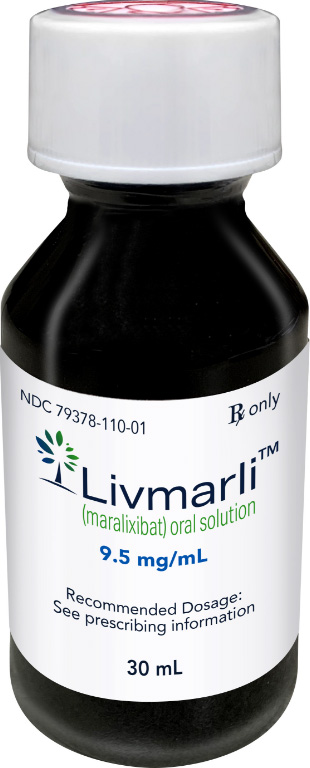A Once-Daily Medicine for Cholestatic Pruritus in Patients With Alagille Syndrome Who are ≥3 Months of Age1

Once-Daily Dosing
The recommended dosage of LIVMARLI is 380 mcg/kg administered orally (PO) once daily (QD), taken approximately 30 minutes before a meal in the morning1
INDIVIDUAL DAILY DOSE VOLUME AND Rx QUANTITY BY PATIENT WEIGHT1
| Patient Weight (kg) | Days 1 to 7(190 mcg/kg once daily) | Beginning Day 8(380 mcg/kg once daily) |
| Volume QD (mL) | Volume QD (mL) | |
| 5 to 6 | 0.1 | 0.2 |
| 7 to 9 | 0.15 | 0.3 |
| 10 to 12 | 0.2 | 0.45 |
| 13 to 15 | 0.3 | 0.6 |
| 16 to 19 | 0.35 | 0.7 |
| 20 to 24 | 0.45 | 0.9 |
| 25 to 29 | 0.5 | 1 |
| 30 to 34 | 0.6 | 1.25 |
| 35 to 39 | 0.7 | 1.5 |
| 40 to 49 | 0.9 | 1.75 |
| 50 to 59 | 1 | 2.25 |
| 60 to 69 | 1.25 | 2.5 |
| 70 or higher | 1.5 | 3 |
Enroll Your Patients
To prescribe LIVMARLI for appropriate patients,
download and fill out the Patient Enrollment Form.
Patient Enrollment Form

Instructions for Use
Should be taken
30
minutes

before a meal
in the morning1
Oral dosing dispenser provided
0.5 mL
1 mL
3 mL

to measure and deliver the prescribed dose accurately1
Please advise patients

household teaspoon/ tablespoon
are not adequate measuring devices2
Storage

Store unopened LIVMARLI at room
temperature between
68 °F and 77 °F
(20 °C and 25 °C)1

After opening the LIVMARLI bottle,
store below 86 °F (30 °C)
—once opened, the bottle can be refrigerated.1

Any remaining LIVMARLI
should be discarded
100 days
after first opening
the bottle1
Clear, colorless to yellow
grape-
flavored
liquid1
Help Your Patients
Get Started
Provide your patients with the full Patient
Information and Instructions for Use for LIVMARLI.
Importance of Adherence
It’s crucial to remind patients that sticking to their therapy is the only way to truly see improvement in their cholestatic pruritus associated with Alagille syndrome. In the ICONIC study, some patients were switched to placebo during the randomized withdrawal period starting at Week 19. Those patients experienced significant increases in cholestatic pruritus. However, once they were switched back to LIVMARLI, their cholestatic pruritus improvements returned.1,3
Of course, human error occurs. If a patient misses a dose of LIVMARLI, advise them it should be taken as soon as possible if within 12 hours of the time it is usually taken. They can then resume their original dosing schedule. If a dose is missed by more than 12 hours, the dose can be omitted and the original dosing schedule resumed.1

Pediatric patients aged 3 months to <12 months had similar safety, tolerability, and pharmacokinetic profiles to those ≥1 year old.1
Root Out
Excess Bile
Learn how LIVMARLI—the first FDA-approved treatment for cholestatic pruritus in Alagille syndrome—battles bile acid buildup.1
See How LIVMARLI Works
Encourage patients to download the Itch✓ app to help them track symptom patterns over time and generate customized reports to share at appointments.
Check Out the Itch✓ App
Mirum Access Plus assists both you and your patients at every turn, helping you navigate the payer approval process—and beyond—with ease.
Learn More AboutMirum Access Plus

